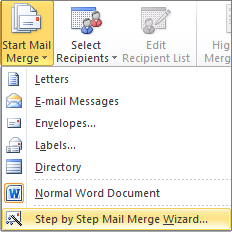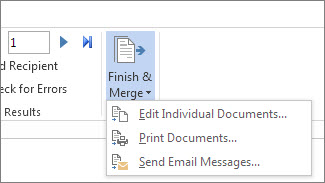

The word doc is working fine if I do it manually by clicking on the merge preview button. I'm confuse on why word still ask me what worksheet the data is coming from when word is fired up. Filename:=ActiveWorkbook.Path & "\1- Tooling Quote_merge.doc" Set oWordApp = CreateObject("word.application") 'word application
#MAIL MERGE FROM EXCEL TO WORD 2010 CODE#
I'm using the follow code snippet to do the merge:ĭim oWordPath As String 'path and file name for the template The datasource for the merge is all located on one worksheet named "merge data" I am trying do a simple mail merge using excel worksheet as datasource. opendatasource Name:=ActiveWorkbook.Path & "\" & ActiveWorkbook.Name, ReadOnly:=True, sqlstatement:="select * from " If the Word document already has the data source attached to it, you do not need the Once I know the version of Word, I can explain how you force a DDE link, so you can record a macro with that connection information. The question is, whether the OLE DB default you'll probably get when you record the macro gives you the right result, or if something in your mail merge requires a DDE connection. The code below successfully opens the appropriate Word template(s) but says that Word could not open the data source. I'd like to automate a mail merge with existing templates already established for the merge. Execute the merge to a new document and check that the result is what you expect.įWIW my best guess is that you previously had a DDE connection. I have an excel workbook where the first sheet is a summary of all accounts and each sheet after is a summary per account. Stop the macro recorder and look at the recorded OpenDataSource method. Mail Merge is a handy feature that incorporates data from both Microsoft Word and Microsoft Excel and allows you to create multiple documents at once, such as letters, saving you the time and effort of retyping the same letter over and over. Start a mail merge and attach to the data source Probably the fastest and simplest thing for you to do would be toģ. With that change, alterations in the connection information for OpenDataSource are required. Excel went from a default DDE connection to OLE DB. Automate Internet Explorer and Chrome (using Selenium) for web tasks. Some of the connection information required also changed in the same Word version. Send emails with attachments from Outlook and Gmail. Since version 2002, opening a mail merge document via automation will cut off the data source, so I don't think Doug's suggestion would apply. However the rest of the steps are self-explanatory. Depending on the options chosen different dialog boxes will show up, making very difficult to provide a step by step for the rest. Follow the rest of the Mail-Merge Wizard. For more info, see Data sources you can use for a mail merge.įor more info, see Mail merge: Edit recipients.įor more info on sorting and filtering, see Sort the data for a mail merge or Filter the data for a mail merge.It would help to know which version of Word is involved, here. Choose the Excel worksheet that has your chosen recipients. Under Select document type, click Letters.

In Microsoft Office Word 2007, click Start Mail Merge in the Start Mail Merge group on the Mailings tab, and then click Step by Step by Mail Merge Wizard. She wonders how she can have the rounded value merged into her Word documents rather than the underlying data that has many more decimal places. In Excel, she can format a cell to round to the nearest two decimal places. Connect and edit the mailing listĬonnect to your data source. In Microsoft Office Word 2003 and in earlier versions of Word, point to Letters and Mailings on the Tools menu, and then click Mail Merge Wizard. Marylea uses mail merge to place information from an Excel worksheet into the merged documents. The Excel spreadsheet to be used in the mail merge is stored on your local machine.Ĭhanges or additions to your spreadsheet are completed before it's connected to your mail merge document in Word.įor more information, see Prepare your Excel data source for mail merge in Word.

For example, to address readers by their first name in your document, you'll need separate columns for first and last names.Īll data to be merged is present in the first sheet of your spreadsheet.ĭata entries with percentages, currencies, and postal codes are correctly formatted in the spreadsheet so that Word can properly read their values. Make sure:Ĭolumn names in your spreadsheet match the field names you want to insert in your mail merge. Here are some tips to prepare your Excel spreadsheet for a mail merge.


 0 kommentar(er)
0 kommentar(er)
